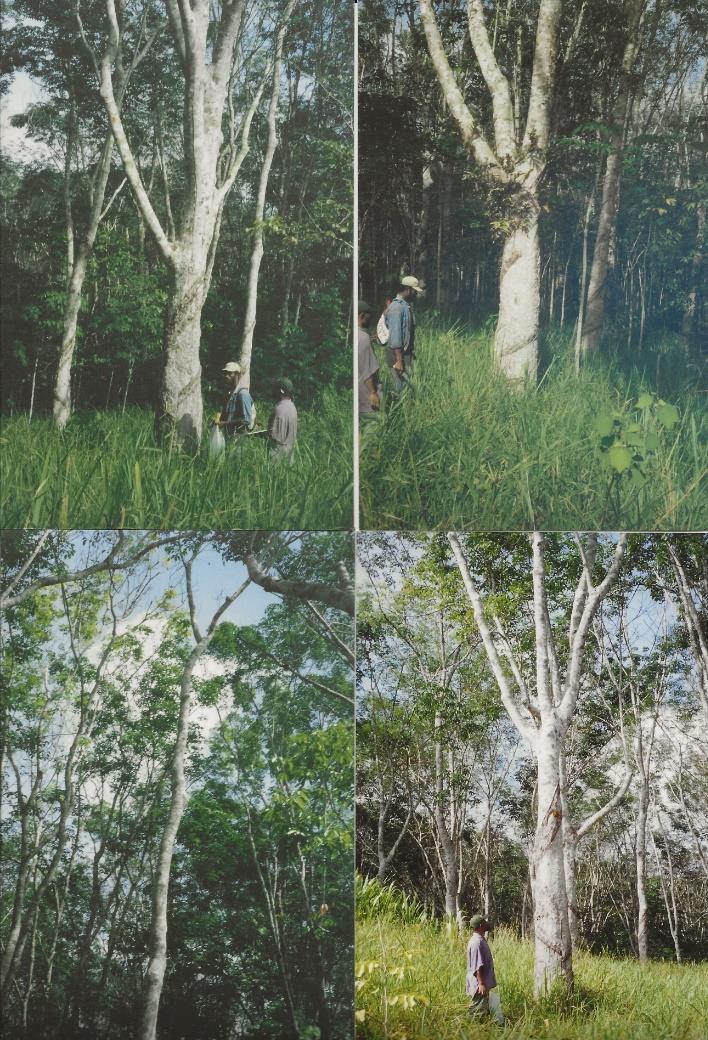
18 minute read
The Use of Forested Lands to Provide Minor Forest Products
The Use of Forested Lands to Provide Minor Forest Products
Minor forest products are those products other than timber of commercial value which can be obtained from trees and other plants in the rainforest.
Advertisement
Powell13 in 1976 described in detail the ethnobotany of the Papua New Guinea people with regard to the staple and supplementary crops, the agricultural systems present and the wild plant resources available for utilisation as food and as raw materials for products of material culture.
There are many useful plants described by Powell including: • Narcotics, stimulants and intoxicants. • Medicinal plants. • Ritual and magic. • Art. • Tools and weapons. • Hunting and fishing. • Canoes and rafts. • House building. • Food preparation including containers and vessels. • Cordage, bark cloth and other textiles. • Clothing and personal ornamentation.
Although, outside the scope of this project, for those readers interested in a detailed description of the various plants used by Papua New Guineans, read: • Powell 1976:108-112 for a listing of over 250 kinds of food plants. • Powell 1976:135-147 for a listing of medicinal plants.
Many of these products lie on the borderline between forestry and agriculture. The following chapters describe some of these plants and their applications.
Perhaps an outstanding example is rubber (Hevea brasiliensis), which provides an important but still minor forest product in it’s native Brazil, but which in Malaysia, PNG and other southeast Asian countries provides an agricultural crop of unequalled importance.
New Rubber Tree Plantation Galley Reach Central Province
PNG.
Photo credit Dick McCarthy 2000.
13 Powell J M 1976 Ethnobotany in Paijmans K(editor) New Guinea Vegetation. ANU Press, CSIRO Canberra.
13
Minor forest products serve a host of needs and are best classified by the type of product they yield.
Elastomers (a natural polymer having elastic properties e.g. rubber.)
A number of rainforest plants produce latex in their stems.This is used to provide a variety of elastomers.
The major elastomer is rubber from the rubber tree ( Hevea brasliensis) which now forms the basis of major industries in many Southeast Asian countries.
Rubber Tree Plantation Sogeri.
Photo credit Dick McCarthy 2000.
Other rainforest plants which have been used on a smaller scale to provide rubber include Castiulla elestica from Central America and Ficus elastica from India.
Other elastomers which are usually obtained by the selective working of trees within the rainforest include:
Chicle, the milky latex of the sapodilla tree from Central American Achras sapota used to make chewing gum. It can also be obtained from trees as the Brazalian Manilkara huberi and the Malayan Dyera costulata.
Balata used in golf balls and telegraphic cables and obtained from northern South Americas species Manilkara bidentata.
Gutta percha is the substance that is used to fill the tooth to prevent reinfection. Gutta percha is a thermoplastic filling that is heated and then pressed into the tooth canals. It is derived from a Malaysian plant Palaquium gutta.
14
Resins
Resisn are used in such products as varnish, paints, certain medicines, ointments and incense. Resins come from a variety of rainforest trees including many species of Burseranceae, Dipterocarpaceae (vatica resin) and from Araucariaceae as Agathis sp.(copal).
Edible Oils
Edible oils are found in the fruit of many tropical rainforest plants.
Oil palm (Elaeis guineesis) from West Africa. It has oil rich fruit. Palm oil is an edible vegetable oil derived from the mesocarp of the fruit of the oil palm. The oil is used in food manufacturing such as margarine, in beauty products such as soap, and as biofuel. Palm oil accounted for about 33% of global oils produced from oil crops in 2014. Oil Palm plantations now exist in many countries.
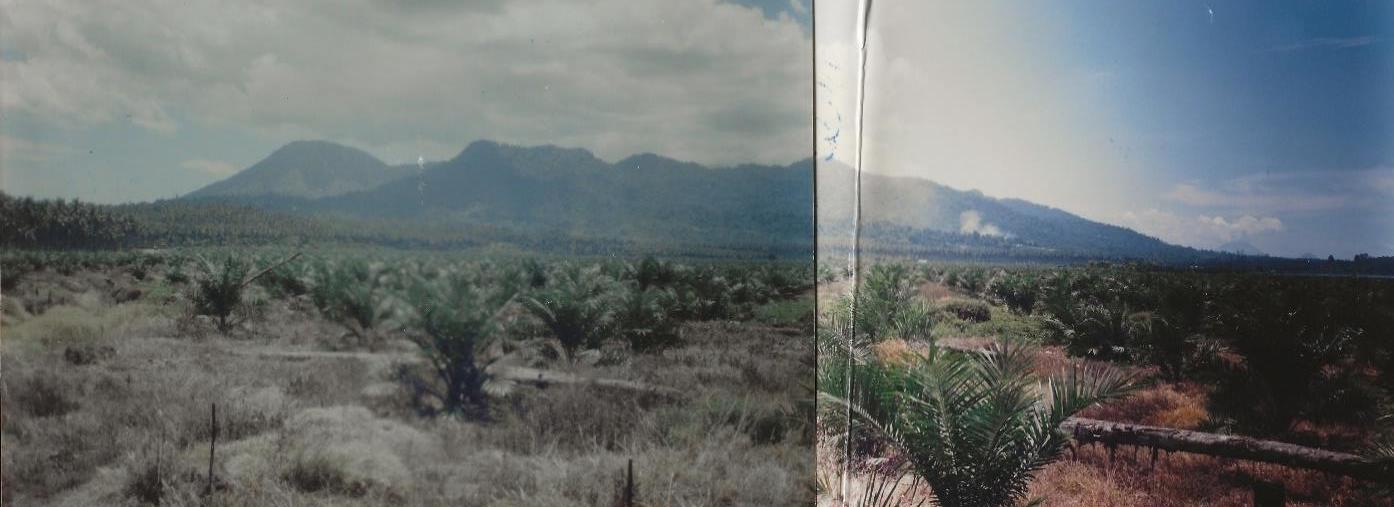
Oil Palm Plantings Hoskins New Britain. Photo credit Dick McCarthy 1995.
Drugs and Medicinal Products.
Drugs and similar products are obtained from many rainforest plants.
Hyoscine is used in the treatment of mental illness and travel sickness. It is obtained from the leaves of a common secondary tree species Duboisia myoporoides.
Certain Strychnos spp. are noted for the presence of poisonous indole alkaloids in the roots, stems and leaves of various species. Among these alkaloids are the well-known and virulent poisons as strychnine and curare.
Medicinal camphor comes from the rainforest species Cinnamomum camphora.
The source of cocaine comes from the Andrean species Erythoxylum coca.
15
An important insecticide comes from the roots of the leguminous vines Derris spp. and Lonchocarpus spp.
The neem tree of India, Azadirachta indica provides a strong smelling aromatic oil (obtained from the fruit) which is used to treat malaria, rheumatism etc.
Many more examples abound of drugs and medicines obtained from rainforest species.
Essential Oils
The distillation of essential oils is not widely practised in tropical rainforest areas but some specific examples include:
Cinnamon is a spice obtained from the inner bark of several tree species from the genus Cinnamomum e.g., Cinnamomum culilawan bark provides essential oils as eugenol and saffrol for food flavouring, perfumes and pharmaceuticals.
Massoy essential oil (Cryptocarya massoy). Before World War 2, massoy oil was exported from West New Guinea (West Irian). Massoy essential oil was once widely used as a natural coconut flavouring and other food flavouring, perfumes and pharmaceuticals. It has been largely superseded by a synthetic alternative because the extraction process is expensive and the process of removing the bark kills the tree.
Rosewood oil. The Amazonian species Aniba roseodora, the wood of which is distilled to provide rosewood oil, much valued in perfumery.
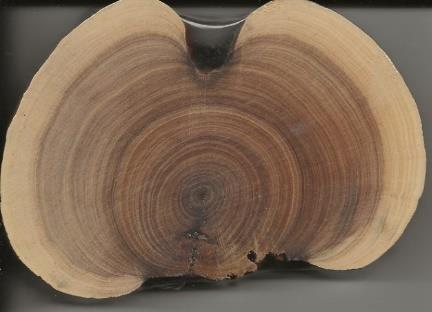
Sandalwood oil obtained from the reddish heartwood of Santalum spp. which is used in perfumery.
Source Dick McCarthy.
Eucalyptus oil distilled from the leaves of Eucalyptus spp. which is used in medicine as an antiseptic and in perfumery.
Eucalyptus Leaves in small steam distillation unit. Source Wikipedia.
16
The wood of the gaharu tree (Gyrinops ledermanii) in PNG is known as eaglewood or
agarwood. Gyrinops is closley related to Aquilaria spp. In the past all species were considered to belong to Aquilaria .Agarwood, aloeswood, eaglewood or gharuwood is a fragnant dark resinous wood producing an oil, much valued in perfumery, incense and small carvings. It is formed in the heartwood of the tree when they become infected with a type of mould (Phialophora parasitica.).
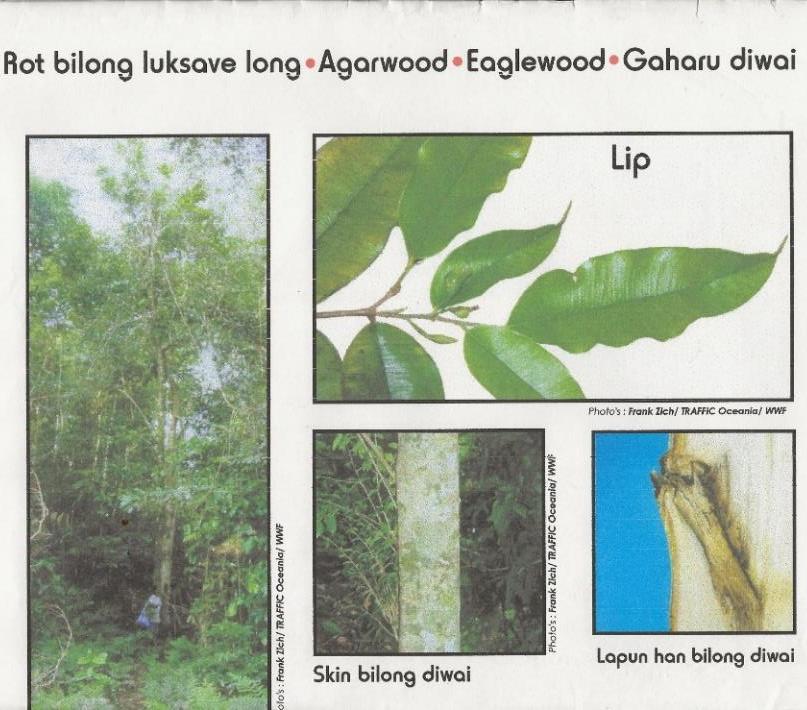

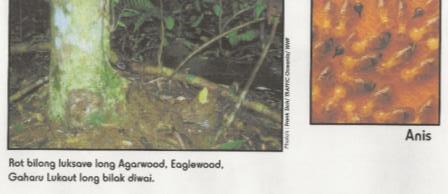
17
Fruit and Other Foodstuff
The fruits of many rainforest plants are edible and provide a valuable source of food.
Trees which provide edible fruits include:
Breadfruit (Artocarpus altilis) is a species of flowering tree in the mulberry and jackfruit (Artocarpus heterophyllus) family (Moraceae). It is believed to be a domesticated descendant of Artocarpus camansi originating in New Guinea, the Maluku Islands, and the Philippines.
Artocarpus spp. (breadfruit).
Source Wikipedia.
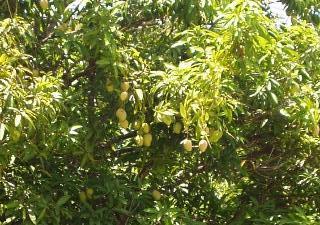
Mango (Mangifera indica) Port Moresby.
Photo credit Dick McCarthy 2000
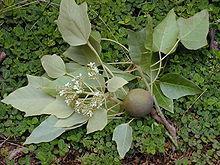
Candlenut. Aleurites moluccana). Both the nut and the oil that can be extracted from it are used. While mildly toxic when raw, the nut is appreciated in many cultures once cooked or toasted.
Candlenut foliage and nut.
Source Wikipedia.
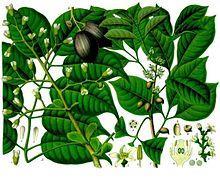
Galip Nut. (Canarium indicum), is a mainly dioecious tree native in eastern Melanesia. It is usually found in rainforest, secondary forests, old garden areas, around villages and settlements. It is also used as a shade tree. It is important in the world food system as it can be used as a food and timber source, in traditional medicine and intercropping.
Source Wikipedia.
18
There are many rainforest fruit bearing plants now propagated commercially in plantations around the World. Examples include plants such as:
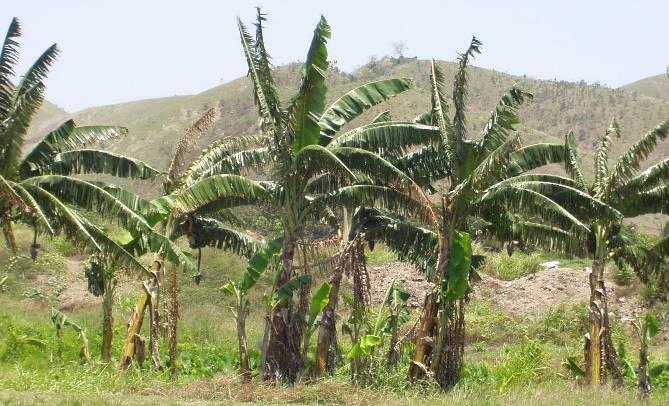
Musa (Banana) Port Moresby.
Musa species are native to tropical Indomalaya and Australia. They are likely to have been first domesticated in Papua New Guinea. They are grown primarily for their fruit, and to a lesser extent to make fibre.
Photo credit Dick McCarthy 2000.
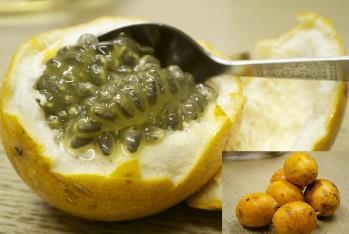
Passiflora (passionfruit).
Source Tok Pisin.
The fruits of some plants, though not providing a direct foodstuff are used in the manufacture of edible products as:
Cocoa bean Theobroma cacao (cocoa bean or simply cocoa) is native to Central and South America. It is used in chocolate manufacture and beverages. Cocoa bean is the dried and fully fermented seed from which cocoa solids (a mixture of non-fat substances) and cocoa butter (the fat) can be extracted.

Cocoa Pods at various stages of ripening.
Cocoa beans: with flesh, without flesh, without flesh and skin. Source Wikipedia.
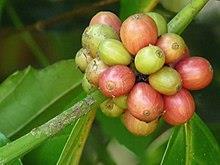
Berries of Coffea canephora. (syn. Coffea robusta) Source Wikipedia.
It is commonly known as robusta coffee. It is a species of coffee that has its origins in central and western subSaharan Africa. Though widely known as Coffea robusta, the plant is scientifically identified as Coffea canephora.
Coffea robusta represents 43% of global coffee production, with Coffea arabica constituting most of the remainder. There are several differences between the composition of coffee beans from C. arabica and C. robusta. Beans from C. robusta tend to have lower acidity, more bitterness, and a more woody and less fruity flavor compared to C. arabica beans.
19

Coffea arabica fruit
Source Wikipedia.
Tea. Camellia sinensis (tea) a native of northeast India. Camellia sinensis is a species of evergreen shrubs or small trees in the flowering plant family Theaceae whose leaves and leaf buds are used to produce tea.
Macmillian14 in 1935 reported that tea is supposed to originally have belonged to two varieties of Camellia Thea. Var Viridis (a synonym of Camellia sinensis) L) Kuntze) is a native of NE India and origin of most varieties whereas var Bohea is from China.
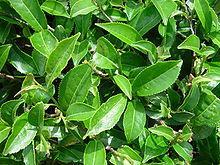
Other rainforest species provide products from parts of the plant:
Spices and condiments from their fruits as Capsicum. (peppers).
Buds as Eugenia caryophyllata (cloves).
Roots or tubers Zingiber officinale (ginger), Colocasia esculentum (taro), Dioscorea spp (yams).
Bark.
Bark as Cinnamon zeylanicum (cinnamon). Cinnamon is a spice obtained from the inner bark of several tree species from the genus Cinnamomum e.g., Cinnamomum culilawan bark provides essential oils as eugenol and saffrol for food flavouring, perfumes and pharmaceuticals
Bark of the Cinchona tree provided extracts for quinine in 1820. The original source of quinene for the treatment of malaria came from an Andean species Cinchona officinalis. It is native to Peru. Bark extracts from the cinchona tree have been used to treat malaria since at least in 1632.It was introduced into Spain as early as 1636 by Jesuit Missionaries. The bark of several species yields quinine and other alkaloids that were the only effective treatments against malaria during the height of European colonialism, which made them of great economic and political importance. The artificial synthesis of quinine in 1944, an increase in resistant forms of malaria, and the emergence of alternate therapies, eventually ended largescale economic interest in cinchona tree plantation cultivation.
14 Macmillan H F 1935 Tropical Planting and Gardening with special reference to Ceylon. Publisher MACMILAN & CO London Fifth Edition 1943. Reprinted 1962.
20
Bark extract (Cutch) for Tannin production from mangroves and other species. Cutch can be used variously as a food additive, astringent, tannin, and dye. It is extracted from several species by boiling the wood in water and evaporating the resulting brew.
In PNG, in 1949 there was the commencement of a tannin extracting industry based on the mangrove forests of the Gulf of Papua, which threatened to leave to waste vast quantities of timber following commercial stripping of the bark.

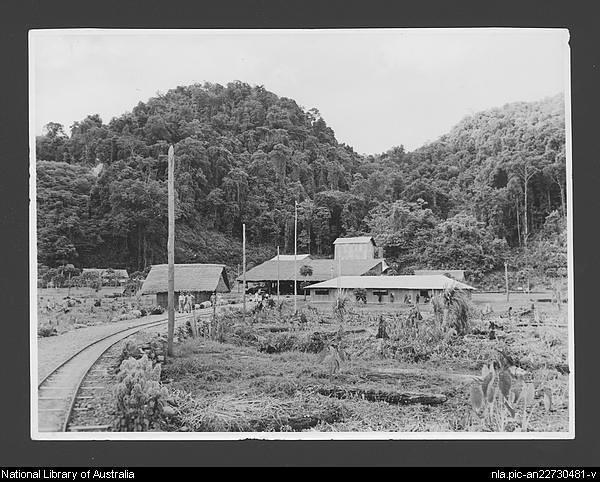
Cutch Factory, Aird Hills, Papuan Gulf. The steamer 'Narani' was used to transport processed cutch to Port Moresby in the early 1950s. Photo credit National Library of Australia.
In 1951 Narani was sold to the New Guinea Borneo Mangrove Company and taken to Aird Hills in the Kikori River Delta, Papua. Its role was to transport cutch - bark harvested from mangrove trees and processed - to Port Moresby. The cutch factory had a railway line to transport bark to the processing plant and then transport processed cutch back to the Narani
The Australian Women's Weekly Wednesday 27 June 1951 published this account: "English couple Charles and Phyllis Cook left Sydney in the old N.S.W. coaster Narani recently, counting the days till they are back in the jungle. Mr. and Mrs. Cook are on their way to a river delta at Perome, 300 miles from Port Moresby, in Papua, where they will establish a factory to make a bark extract from native trees.
21
The Cooks like jungle life. Before coming to Sydney, where their ship took on six months' supplies and equipment, they lived in Borneo.
In Borneo Mr. Cook was managing a factory producing bark extract, which is called cutch, and is used to dye materials khaki and to preserve fishing nets. The bark extract, then made from a type of wattle in India, was used to colour British military uniforms khaki last century after the War Office had decided that the resplendent redcoats were too easily spotted by the enemy.
Mr. Cook will use mangrove bark to make the extract in his Papuan factory. It is claimed that this type of bark produces the best dye."
Perome is a small village near Aird Hills on the Delta of the Kikori River. Most of the Delta area is a flood plain largely supporting Sago Palm. Aird Hills is relatively close to the Gulf of Papua and deep-water access to the volcanic hills. It is these conditions that allow mangroves to develop and provided a resource for a cutch factory to be established.
Michael Pearson1 in his book, The End of the Line described PNG's Great Train Robbery: The cutch factory was the centre of a notorious event described brilliantly in PNG's Railway History
"The Borneo New Guinea Mangrove Company established a pioneer factory in the swamps of the Kikori River Delta at Aird Hills to extract cutch (a tanning fluid from mangrove bark). A short tramline (about 1300 metres) was built from the wharf to the factory. It carried firewood and the bark inwards, and cutch out for shipment. There was a small IC-engined locomotive which hauled flat trucks and hopper wagons over the line. By 1958 the venture had failed, and the equipment was abandoned. Mr. Keith Tetley, a local trader, collected rails to build a wharf and copra drier.
Steamships Trading Company (STC) eventually purchased the assets of the Borneo New Guinea Mangrove Company from receivers with the intention of using them at their Baimuru Sawmill. On arrival to collect their bounty, STC crews discovered its disappearance. Whereabouts of the railway equipment was soon discovered, and the company took Mr. Tetley to court, thus commencing the case of PNG's Great Railway Robbery. Mr Tetley eventually won the case as there was no caretaker at the site and the rails were not on land belonging to the company, and therefore, they could be considered abandoned. He is reported to have arrived at the Kerema Hall for the annual Christmas party pulling a toy train, much to the delight of those present. STC lost out badly, not only losing the rails and the money paid for them but also having to pay court costs.
Source Wikipedia.
22
Stems
Stem as Metroxylon sagu (sago).
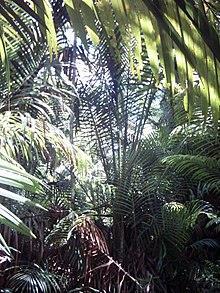
L to R. Sago palms (Metroxylon sagu) in New Guinea. Source Wikipedia.Making sago in Papua Source 1913 Sydney Mail Annual.
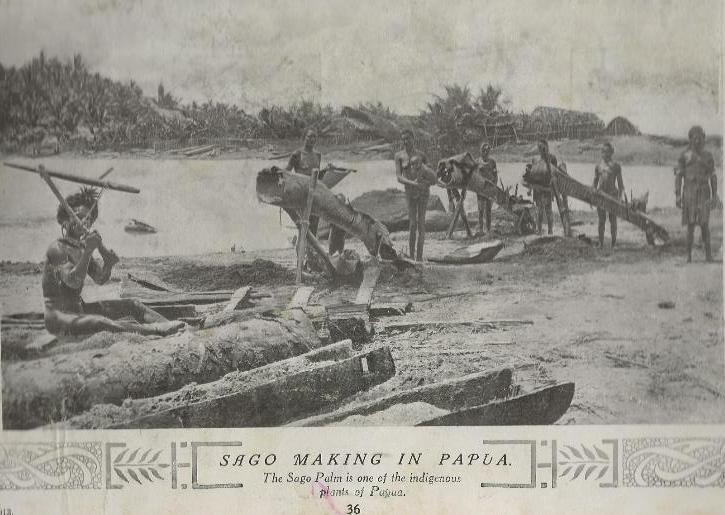
Sago is extracted from Metroxylon palms by splitting the stem lengthwise and removing the pith which is then crushed and kneaded to release the starch before being washed and strained to extract the starch from the fibrous residue. The raw starch suspension in water is then collected in a settling container.
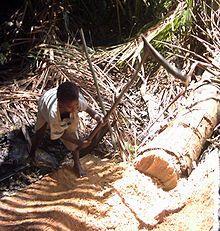
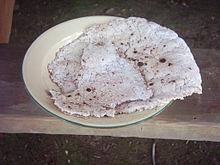
L to R. A sago palm being harvested for sago production. A sago starch filter. Sago pancakes. Source Wikipedia.
23
Palms are among the best known and most extensively cultivated plant families. They have been important to humans throughout much of history. Many common products and foods are derived from palms. In contemporary times, palms are also widely used in landscaping, making them one of the most economically important plants. Palm products such as coconut, is the fruit of the coconut palm (Cocos nucifera). It's used for its water, milk, oil, and tasty meat. Coconuts have been grown in tropical regions for more than 4,500 years.
15
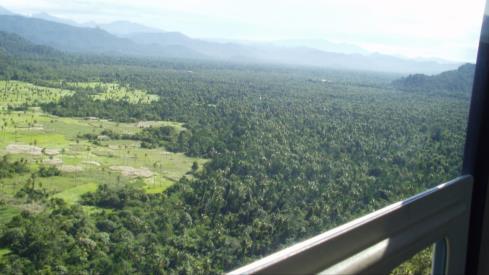
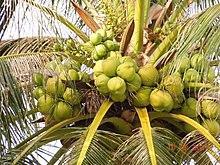
Aerial View Robinson River Coconut Plantation. Photo credit Dick McCarthy
2005.Robinson River plantation Abau was one of the biggest coconut plantations in Papua comprising some 3,400 acres of plantation producing some 1000 tons of copra annually, with regular DC3 loads of beef to Port Moresby. There were over 20 miles (31 kms) of railway lines throughout the plantations for transport of coconuts to a central copra drier. During World War 2, the Australian Army removed the railway lines. It was purchased by Burns Philip in 1936. It had been originally developed and managed for the Horn family by BNGD.
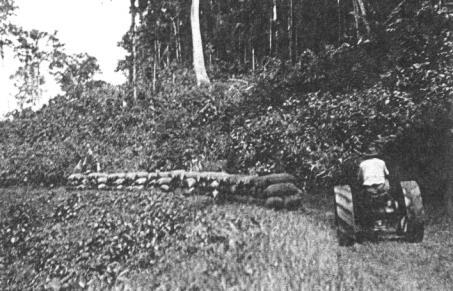
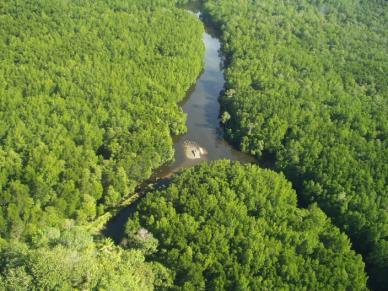
Trasporting copra to jetty in 1936. Abandoned Jetty.
Source PNG National Archives. Photo credit Dick McCarthy 2005.

Abandoned plantation buildings. Abandoned airport terminal and overgrown airstrip. Photo credit Dick McCarthy 2005.
15 McKillop R F & Pearson M 1977.End of the Line. A History of Railways in PNG. ISBN 998084096x UPNG Press. Lewis DC 1996. The Plantation Dream. ANU Press. ISBN 0959547789 24
Other Types of Products from Rainforest Plants include:
Fibres such as rattans, bamboos, canes, raffia.
Crossing a cane suspension bridge with part of their gear on the Jimi Valley Survey.
Photo credit Paul Ryan.
Water Craft Construction Lakatoi Papa Lei Central Province.
Photo credit Dick McCarthy.
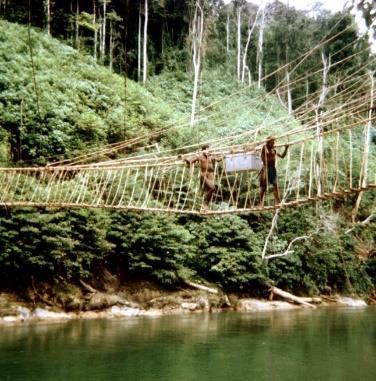
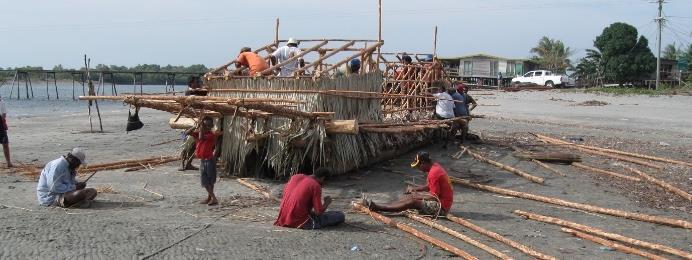
Dyes used for colouring textile.
Kapok (Ceiba pentandra). This is a tropical tree native to Mexico, Central America, and Northern South America. The tree is cultivated for the cotton like fluff from its seed pods. The fibre is light, very buoyant, resilient to water but very flammable. The fibre is used as an alternative to down as filling in mattresses, pillows, upholstery, and stuffed toys as teddy bears and for insulation. It was previously used in life jackets and similar devices until synthetic materials largely replaced the fibre. The seeds produce an oil that is used locally in soap and can be used as fertiliser.
Single dehiscent fruit revealing kapok-surrounded seeds.
Source Wikipedia.
Seeds visible within fibres of dehisced fruit with shrivelled valves.
Source Wikipedia.
Food Plants.
25
Many plants are gathered from the forests and used as vegetables. These vegetables can be the leaves of trees (e.g., Ficus) shoots and stems of trees, vines, bamboos, fern fronds, cabbage heart of palms, edible grasses, or parts of ground plants.
Fruits, nuts, and seeds.
Some fruits include lau lau (Syzygium malaccense and S agueum), taun (Pometia pinnata) and Ficus species.
Nuts
Galip Nut (Canarium sp)
Pandanus nuts in the Highlands.
Seeds
Okari seeds. (Terminalia species)
Medicinal Plants
16Some examples of the way plants are used in PNG include:
• To treat cuts and wounds e.g., wild daka leaves, ginger leaves. • For burns e.g., chewed up leaves of taun and galip. • For skin diseases and sores e.g., sap of Ficus sp. • For dressings and bandages e.g., palm fibre or leaves. • For general body pains e.g., Ficus leaves. • For toothache e.g., ginger plants. • For ear and eye infections. • For coughs and colds e.g., inhaling the smoke of the fern Polypodium. • For lung problems and tuberculosis. • For stomach aches, dysentery, and diarrhea. e.g., some palm species and gingers. • For fever, including malaria. • For poisons e.g., the smell of some rhododendron flowers causes vomiting. • For fertility and childbirth. Fungi (Mushrooms)
16 Non-Timber Forest Products – Alternative ways to use the forests of Papua New Guinea. 1995. Foundation of the Peoples of the South Pacific and Australian Foundation for the Peoples of Asia and the Pacific Ltd. ISBN 9980851171.
26
PNG Bulolo Investigations for Shitake.
Dr Bob Thistlethwaite was involved with Dr Kisaku Mori D. Agr., supported by a small team of Japanese scientists and officials, to investigate the presence of Shitake in PNG. Jack Simpson, Department of Forests pathologist based at Bulolo in Morobe Province, guided the Mori team to Castanopsis forests where Shitake was identified on the first morning of the field visit. After Dr Mori’s field visit, Shitake was found widely distributed on Fagaceae, especially on Castanopsis in the highlands of PNG. At the Tari market in Hela Province, different varieties of edible mushrooms were being sold. Shitake was known locally “abus long abus” or meat with meat and was highly prized.
Kevin White Assistant Director PNG Forests greets Dr Kisaku Mori and the OIC Mori Research with Bob Thistlethwaite at the Davara on Ela Beach Port Moresby.
Mori research team: The 6-man Mori team arrive at Bulolo.
Shitake party 1: L to R: Bob Thistlethwaite, Egon Horak, Jack Simpson, Dave Lamb, Kisaku Mori.
Shitake party 2: L to R: Bob Thistlethwaite, Jack Simpson, Dave Lamb (partly obscured at rear), OIC Mori Research, Egon Horak, Kisaku Mori in Castanopsis forest at Bulolo.
Photo credits Bob Thistlethwaite.
27







